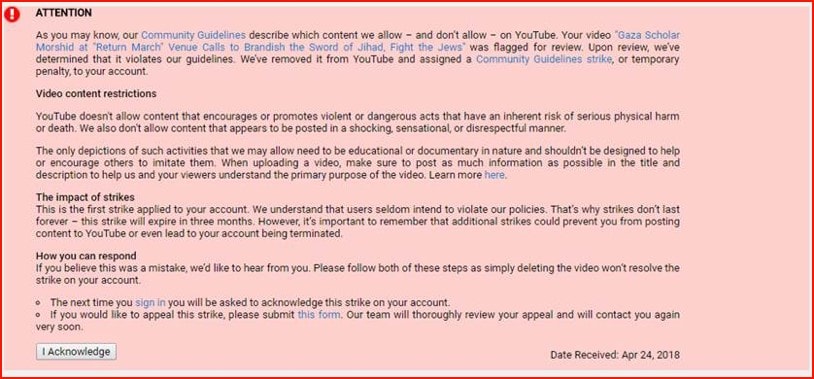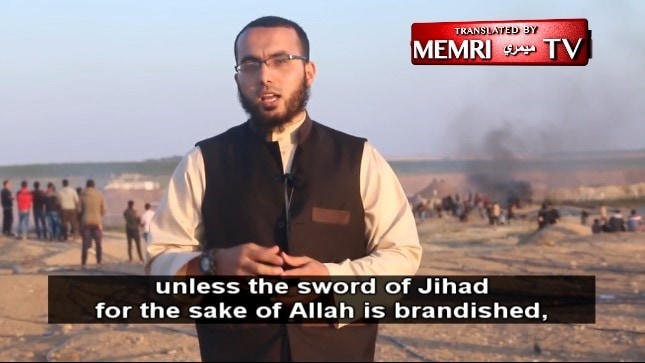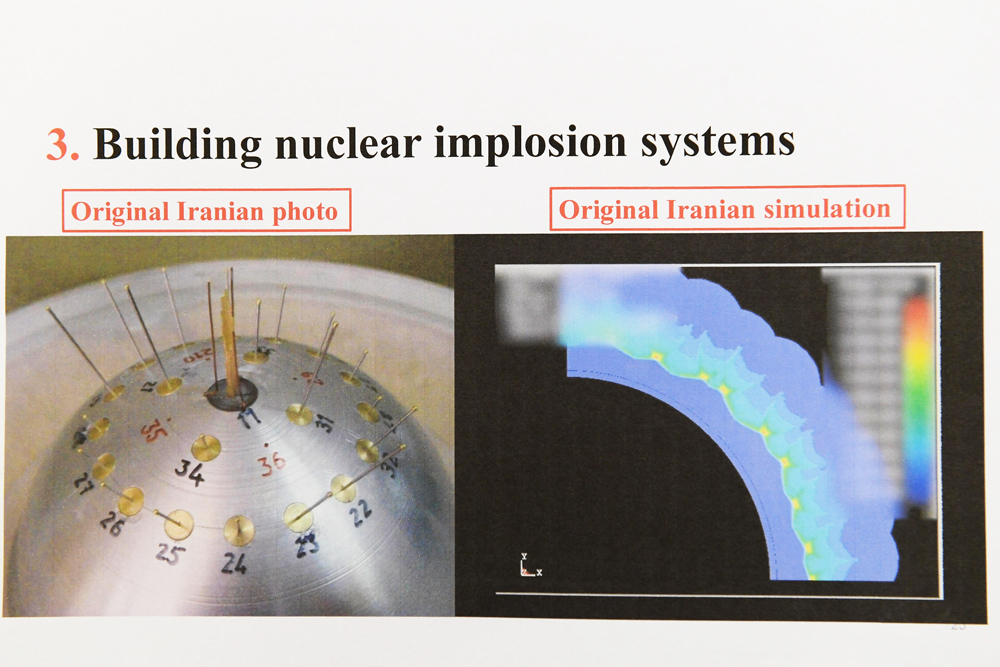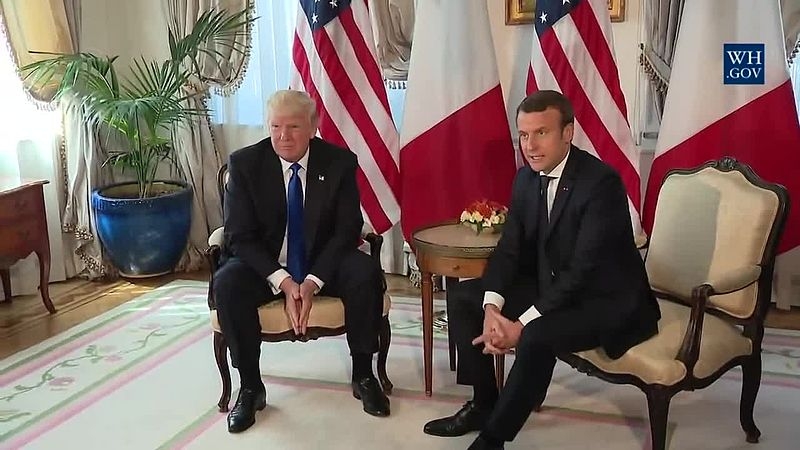by Maj. Gen. (res.) Gershon Hacohen
Hamas is using these events as a springboard for a strategic achievement that could have major consequences.

Palestinian participating in March of Return, screenshot from YouTube video
BESA Center Perspectives Paper No. 821, May 3, 2018
EXECUTIVE SUMMARY: When
it comes to defending the Gaza border against the physical threat, the
responsibility of the Chief of Staff and the commander of Southern
Command is clear-cut and well fulfilled. That, however, does not
constitute a sufficient response to Hamas’s effort to turn the border
fence events into a strategic achievement.
Jews have known existential anxiety for
generations, and the potential for existential danger has become the
main criterion by which Israeli leaders tend to assess threats –
including the extent to which they are strategic. Based on this
criterion, Prime Minister Yitzhak Rabin determined, with the support of
security experts, that terrorism does not constitute an existential
threat.
Indeed, when a ground offensive by regular armies
forms the benchmark for an existential threat, the dangers posed by
terrorism – let alone by the events currently occurring along the Gaza
border – are not seen as existential. But Hamas is using these events as a
springboard for a strategic achievement that could have major
consequences.
A strategic threat requires a strategic response,
one that entails preparations for a multidimensional campaign that is
waged at the national level with the state of Israel’s full resources
and capabilities. A strategic response of this kind must address four
basic aspects of the situation:
- Identifying the change in the reality and internalizing new trends. The events along the fence constitute a new operational campaign against Israel that Hamas is conducting directly and in a centralized manner. In the public sphere, the campaign, with its well-crafted stage set, is presented as an unarmed civil revolt. At the covert level, however, it is fully orchestrated by Hamas making sophisticated use of the tools of the new warfare with a view to influencing three arenas of psychological perception: the Palestinian, the Israeli, and the international.
With impressive
professional skill and in coordination with global networks including
BDS elements, a special effort is also being made to stream the events
into the social networks. As a first stage of strategic assessment, the
change must be identified as a new kind of campaign, most significantly
its branding as the “March of Return.” For while Hamas has never
accepted the two-state solution underpinning the Oslo process, the
explicit branding of the campaign as an effort at destroying Israel –
which is the real meaning of the “return” slogan in Palestinian and Arab
discourse – without this evoking any international opposition requires
the Israeli leadership to intensively discuss an effective
counterstrategy.
- Conceptualizing the new situation and crafting an overall, well-formed theoretical approach. In order to contend with criticisms of the IDF’s actions on the Israeli far left, and Western public opinion more generally, a theoretical foundation tailored to the challenges of the new war must be devised. Over the past decade, the use of civilians as an operational stratagem has assumed a major role in conflict zones. For instance, the Russian government is using local separatists from the civilian population to spearhead the warfare in the Ukrainian region of Donetsk. Similarly, Beijing is making use of thousands of civilian fishing boats in its efforts to extend its sovereignty over the South China Sea. The combined use of civilians at the overt level and of the military system at the covert level, in a supportive secondary effort, is what has given this phenomenon its elusive characteristics. In the West, this is described as “hybrid warfare.” Russian military thinking, which sees an inherent advantage in the ambiguity stemming from combining civilians and soldiers, refers to this phenomenon as the “warfare of the new generation.”
In unprecedented
fashion, the Russian authorities gave public exposure to a lecture
presented by Chief of Staff Valery Gerasimov at the Russian Academy of
Military Sciences in January 2013. Now known in the military world as
the “Gerasimov doctrine,” the lecture articulated a modus operandi
that the Russians have employed for some time, as evident in the recent
campaigns in Georgia (2008), Crimea, and Ukraine. Those campaigns made
deliberate and effective use of the combination of military force and
civilian activity. In the fighting in Georgia, for example, armored
forces were able to enter the north of the country thanks to the efforts
of Russian-oriented Georgian-Abkhaz civilians, who, in a preparatory
move, seized the tunnels and bridges of the expressway that leads to the
capital, Tbilisi.
Against this backdrop,
the images arriving from the confrontation along the Gaza fence need
not be interpreted as IDF units suppressing civilian protests but as IDF
forces protecting the kindergartens and civilians of the Nahal Oz and
Kerem Shalom kibbutzim, which are about 200 meters from the fence and
under threat from a terror organization in civilian guise.
This revised
theoretical foundation will help rebut, from a new perspective, the
false accusations directed at IDF soldiers. It will explain, for
example, the potential threat posed to Israeli civilians in border
communities by seemingly unarmed violent protesters and how this threat
justifies the rules of engagement. It will elucidate why there is no
alternative to the use of sniper fire and why nonlethal weapons and
standard means of dispersing civilian demonstrations are not applicable
to the circumstances of this threat.
- Adapting the organizational structure to change. A new challenge calls for reassessing the organizational structure’s compatibility with the changing reality. Israel made such a reassessment when preparing for the unilateral disengagement from Gaza in the summer of 2005. Along with organizing units and combined command systems for the IDF and the Israel Police, task-specific administrations were set up in government ministries to address the wide range of issues beyond the military effort. Likewise, the ongoing campaign along the Gaza fence mandates a special organizational response at the national level.
While the
responsibility of the Chief of Staff and the commander of Southern
Command is clear-cut and ably fulfilled, the organizational approach
must be adapted to the demands of the psychological arena, with all its
legal, diplomatic, and public-diplomacy aspects. The IDF Spokesperson’s
Unit, the Foreign Ministry, and the public-diplomacy apparatus in the
Prime Minister’s Office can, of course, retain responsibility for the
domain of perception. Yet, as the challenge intensifies, a special new
organization is required for mobilizing Israel’s full range of
capabilities for an effort at the national level.
- Planning and managing the endeavor in accordance with a strategic objective. An operation of such scope requires precise and deliberate attunement with the strategic purpose, the suitability of which must be constantly reassessed as the campaign develops. This will also necessitate a new plan to alleviate humanitarian distress in the Gaza Strip as well as a new political approach, one that views Gaza as a de facto state and strives, in keeping with Israeli interests, to bolster its status as an independent political entity that is separate from the Palestinian Authority in Ramallah.
To the best of my knowledge, preparations at the
national level for the required strategic endeavor – in the above four
areas – have yet to be conducted. In light of the new challenge posed by
Hamas, which will likely escalate in the coming weeks, one cannot
overstate the urgency of such preparations.
BESA Center Perspectives Papers are published through the generosity of the Greg Rosshandler Family
Source: https://besacenter.org/perspectives-papers/gaza-border-fence-riots/
Follow Middle East and Terrorism on Twitter
Copyright - Original materials copyright (c) by the authors.












